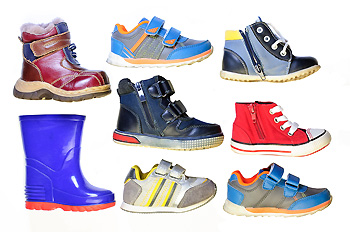
Toddlers are usually flat-footed when they start to walk, and their feet may turn inward known as in-toeing. Flat feet should resolve as bones develop and the feet become stronger. In-toeing should also improve with age. Toddlers should go barefoot or wear soft-soled shoes to promote balance, posture, and coordination. Children receive important sensory information from the soles of their feet touching the ground and they develop muscle strength this way. When children have been walking confidently for some time, they can begin to wear firmer-soled shoes. Footwear can help protect their feet from injury and temperature. Their feet should be professionally measured for length and width. Kids' feet grow quickly, and their shoe size may change every few months. Shoes that are too tight can negatively affect a child’s walking pattern and cause other problems like ingrown toenails. Instead, children’s shoes should be comfortable, with plenty of room in the toe box. They should have a flexible, flat sole that can bend near the toe. The front of the shoe should be wider than the heel, to match the foot's natural shape. The shoes need to be secured with laces or straps that prevent the foot from moving or slipping. See a podiatrist if your child is experiencing foot pain or if you are concerned with how they walk.
The health of a child’s feet is vital to their overall well-being. If you have any questions regarding foot health, contact one of our podiatrists of Advanced Ankle & Foot Surgeons. Our doctors can provide the care you need to keep you pain-free and on your feet.
Tips for Keeping Children's Feet Healthy
- Make sure their shoes fit properly
- Look for any signs of in-toeing or out-toeing
- Check to see if they have Clubfoot (condition that affects your child’s foot and ankle, twisting the heel and toes inward) which is one of the most common nonmajor birth defects.
- Lightly cover your baby’s feet (Tight covers may keep your baby from moving their feet freely, and could prevent normal development)
- Allow your toddler to go shoeless (Shoes can be restricting for a young child’s foot)
- Cut toenails straight across to avoid ingrown toenails
- Keep your child’s foot clean and dry
- Cover cuts and scrapes. Wash any scratches with soap and water and cover them with a bandage until they’ve healed.
If you have any questions, please feel free to contact our office located in O'Fallon, and New Baden, IL . We offer the newest diagnostic and treatment technologies for all your foot care needs.
